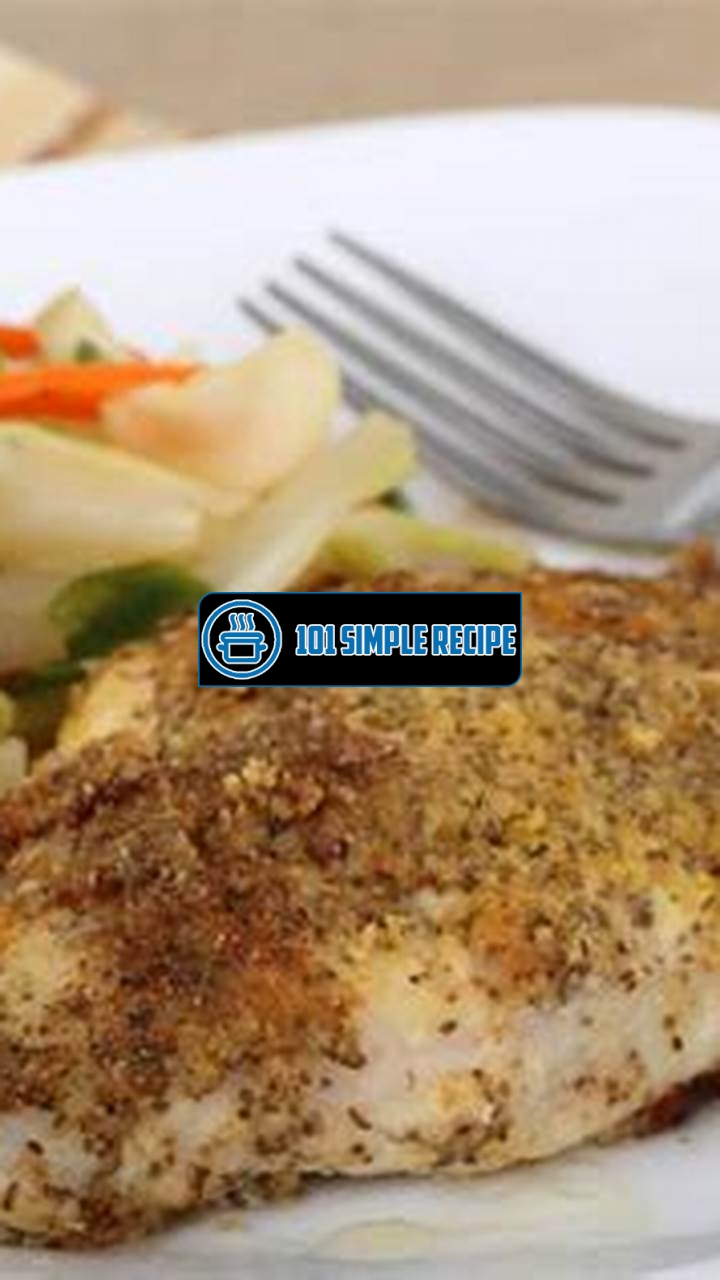If you’re looking for a meal that is both delicious and satisfying, then this Delicious and Crispy Breaded Catfish Recipe is perfect for you. ️ This recipe combines the delicate flavors of catfish with a crispy breading that will leave your taste buds craving for more. With just a few simple ingredients and easy steps, you can enjoy a restaurant-quality meal in the comfort of your own home. So, grab your apron and get ready to impress your family and friends with this mouthwatering dish.

Understanding Breaded Catfish Recipe
When it comes to preparing a delicious and crispy breaded catfish recipe, there are a few key aspects you need to understand. By mastering these aspects, you can elevate your catfish dish to perfection and satisfy your taste buds. Let’s dive into the details of a breaded catfish recipe and learn how to prepare it like a pro.
What is Breaded Catfish
Breaded catfish refers to the culinary technique of coating catfish fillets with a layer of breading before cooking. The breading is typically made from a mixture of flour, breadcrumbs, spices, and herbs. These ingredients add flavor and create a crispy texture on the outside of the catfish, while still maintaining a tender and juicy interior.
Tip: Breaded catfish is a popular dish in many Southern and Cajun cuisines, known for its satisfying crunch and succulent taste.
Benefits of Breaded Catfish
Why should you consider making breaded catfish? Well, besides the irresistible taste, there are several benefits to enjoy:
- High in Protein: Catfish is a great source of lean protein, making it a healthy choice for a balanced diet.
- Rich in Omega-3 Fatty Acids: Catfish is also packed with omega-3 fatty acids, which are essential for heart health and brain function.
- Versatile: You can serve breaded catfish as a main course, in sandwiches, or even in tacos, allowing for a variety of delicious meal options.
- Easy to Prepare: With the right technique, breaded catfish is a simple and quick dish to make, ideal for busy weeknight dinners.
️ Fun Fact: Breaded catfish is often featured on menus at seafood restaurants, as it appeals to a wide range of palates and is relatively easy to prepare in large quantities.
Breading Techniques
Now that you understand what breaded catfish is and its benefits, let’s explore some key breading techniques to take your recipe to the next level:
- Standard Breading Procedure: This technique involves coating the catfish fillets in a three-step process: first, dredging them in flour, then dipping in beaten eggs, and finally, coating with breadcrumbs. Each layer adds flavor and helps the breading adhere to the fish.
- Panko Crust: Panko breadcrumbs are known for their light and crispy texture. Using panko breadcrumbs instead of regular breadcrumbs can give your breaded catfish an extra crunch.
- Seasoning: To enhance the flavor of your breaded catfish, season the flour mixture with spices, such as paprika, garlic powder, or cayenne pepper. This step adds depth and complexity to the overall taste.
- Deep-Frying vs. Baking: While traditional breaded catfish is deep-fried for maximum crispiness, you can also achieve a delicious result by baking the fillets in the oven. Baking offers a healthier alternative without compromising the taste.
Note: Experiment with different breading techniques and find the one that suits your taste preferences and dietary needs.
Now that you have a better understanding of a breaded catfish recipe, its benefits, and various breading techniques, it’s time to put your newfound knowledge into practice. Have fun experimenting in the kitchen and enjoy the delightful experience of cooking and savoring a crispy and delicious breaded catfish dish!
Selecting the Perfect Catfish
If you want to create a delicious and crispy breaded catfish recipe, choosing the right catfish is crucial. The quality of the catfish you select will directly affect the taste and texture of the dish. In this section, we will guide you on how to choose the best catfish for your recipe, ensuring a mouthwatering outcome.
Fresh vs. Frozen Catfish
When it comes to selecting catfish for your breaded recipe, you will come across two options – fresh and frozen. Each has its pros and cons. Let’s take a closer look:
- Fresh Catfish: Opting for fresh catfish provides you with the advantage of superior flavor and texture. Fresh catfish tends to be more tender and succulent, resulting in a more enjoyable eating experience. It also allows you to inspect the fish for freshness before making a purchase. Look for clear eyes, shiny skin, and a mild aroma to ensure freshness.
- Frozen Catfish: Frozen catfish offers convenience and a longer shelf life. It can be a great choice if you don’t have access to fresh catfish or want to stock up on catfish for future use. Frozen catfish is often flash-frozen at its peak freshness, which helps preserve its flavor and texture. Make sure to buy frozen catfish from reputable brands or suppliers to ensure its quality.
Types of Catfish for Breading
Not all catfish varieties are created equal when it comes to breading. While most catfish species can be breaded and cooked, some are more suitable for this cooking method. Here are a few types of catfish that work particularly well for breading:
- Channel Catfish: Channel catfish is one of the most popular choices for breaded catfish recipes. It has a mild, sweet flavor and a firm, flaky texture that holds up well to frying.
- Blue Catfish: Blue catfish is another great option for breading. It has a rich, buttery flavor and a firm texture that lends itself well to frying. Blue catfish fillets are often thick and meaty, making them perfect for a satisfying breaded catfish dish.
- Flathead Catfish: Flathead catfish, also known as yellow catfish, offers a slightly sweeter flavor and a smooth, tender texture. It is often prized for its delicate taste when breaded and fried.
Tips for Buying Catfish
Here are some essential tips to keep in mind when buying catfish for your breaded catfish recipe:
- Source: Purchase catfish from reputable seafood markets or trusted suppliers to ensure its freshness and quality.
- Aroma: Fresh catfish should have a mild, pleasant smell. Avoid fish with a strong, fishy odor as it may indicate poor quality or freshness.
- Appearance: Look for catfish with clear eyes, firm flesh, and shiny skin. Avoid fish with cloudy or sunken eyes, dull or slimy skin, or soft spots.
- Sustainability: Whenever possible, choose catfish that is sustainably sourced to support responsible fishing practices and protect the environment.
By following these guidelines, you can select the perfect catfish for your breaded catfish recipe. Remember, the quality of your ingredients plays a significant role in creating a delicious dish that will impress your family and friends. Happy cooking!
Preparing the Breading Mixture
Master the art of creating a flavorful breading mixture that will take your catfish recipe to the next level. The breading will not only enhance the taste of the fish but also provide a delightful crispy texture. Here’s how you can prepare the perfect breading mixture for your delicious and crispy breaded catfish:
Ingredients for the Breading Mixture
Before diving into the process, gather all the essential ingredients for the breading mixture. You’ll need:
- Bread Crumbs: Start with a generous helping of bread crumbs. Opt for fine bread crumbs for a smoother and more even coating.
- Flour: All-purpose flour is your go-to ingredient for the breading mixture. It helps to bind the coating to the fish.
- Eggs: Eggs act as a binder and help the breading adhere to the fish. Use beaten eggs to achieve the desired consistency.
- Milk or Buttermilk: Adding a splash of milk or buttermilk to the beaten eggs provides moisture and enhances the flavor of the breading.
Seasoning Options
Now that you have your main ingredients ready, it’s time to add some flavorful seasonings that will make your breaded catfish irresistible. Here are a few options:
- Salt and Pepper: A classic combination that adds a basic yet essential flavor to the breading mixture.
- Paprika: For a touch of smokiness and a beautiful reddish hue, paprika is a fantastic addition.
- Garlic Powder: If you’re a garlic lover, adding a hint of garlic powder will elevate the taste of your catfish.
- Onion Powder: Adding a dash of onion powder lends a subtle onion flavor that complements the fish.
- Cayenne Pepper: For those who prefer a bit of heat, a pinch of cayenne pepper will add a delightful kick to the breading mixture.
Creating a Crispy Coating
To achieve that perfect, crispy coating on your catfish, follow these steps:
- Step 1: Start by dredging the catfish fillets in flour. This helps the breading stick to the fish.
- Step 2: Dip the floured fillets into the beaten eggs and milk mixture, ensuring they are thoroughly coated.
- Step 3: Transfer the fillets to the bread crumb mixture. Press them gently into the crumbs, ensuring an even and full coating.
- Step 4: Place the coated fillets onto a baking sheet or wire rack and let them rest for a few minutes. This helps the breading set, ensuring a crispier texture when cooked.
Now that your breading mixture is prepared, you’re ready to cook your delicious and crispy breaded catfish recipe. Whether you choose to fry or bake it, the flavorful breading will surely impress your taste buds. Enjoy!
Coating the Catfish
When it comes to getting that perfectly crispy and delicious breaded catfish, the key lies in the coating. The breading mixture used plays a crucial role in achieving the desired texture and taste. Follow these step-by-step instructions to coat your catfish like a pro.
Prepping the Catfish for Coating
Before applying the breading mixture, it’s important to prepare the catfish properly. Start by rinsing the catfish fillets thoroughly under cold water to remove any dirt or impurities. Pat them dry using paper towels, ensuring that they are free of excess moisture. This step is essential as it helps the breading stick better to the fish, resulting in a crispier coating.
Note: Ensure that the catfish fillets are fresh and of high quality for the best results.
Applying the Breading Mixture
Once the catfish fillets are prepped, it’s time to coat them with the breading mixture. Prepare a shallow dish or pie plate with the breading ingredients. The typical breading mixture consists of flour, breadcrumbs, and a combination of seasonings such as salt, pepper, and paprika. You can also add your favorite herbs and spices to enhance the flavor.
Note: Experiment with different seasonings to create your unique flavor profile.
Dredge each catfish fillet in the breading mixture, ensuring that it is evenly coated on all sides. Gently press the fillet into the mixture to ensure maximum adherence. Shake off any excess breading and place the coated fillets on a clean plate or baking sheet.
Tips for Even Coating
To achieve an even coating on your catfish, keep the following tips in mind:
- 1. Use a fork or tongs: Instead of using your hands, use a fork or tongs to handle the catfish fillets during the coating process. This helps to prevent clumping and ensures a more even distribution of the breading.
- 2. Double coat for extra crunch: For an extra crunchy exterior, you can apply a second coat of breading. Simply repeat the dredging process after the initial coating, ensuring the fillets are evenly coated each time.
- 3. Allow the coated fillets to rest: After coating the catfish, allow the fillets to rest for a few minutes. This helps the breading adhere better to the fish, resulting in a crispier texture.
- 4. Deep-fry or oven-bake: Depending on your preference, you can either deep-fry the coated catfish for a golden brown crust or bake it in the oven for a healthier alternative. Both methods yield delicious results.
Note: Remember to adjust the cooking time and temperature accordingly, depending on your chosen cooking method.
With these detailed instructions for coating catfish and some helpful tips, you are well-equipped to create a delectable breaded catfish dish. Enjoy the perfect balance of crispy coating and succulent fish by following this recipe. Happy cooking!
Cooking Techniques for Breaded Catfish
When it comes to preparing a delicious and crispy breaded catfish, the cooking technique plays a crucial role in enhancing the flavors while ensuring that the breading remains perfectly crispy. In this article, we will explore three popular cooking methods for breaded catfish: deep frying, baking in the oven, and pan-frying on the stove. Each method offers a unique approach to achieving that golden, crispy exterior while preserving the moist and tender flesh of the catfish.
Deep Frying
Deep frying is a classic method that provides an irresistibly crispy coating to the catfish. To deep fry your breaded catfish, begin by heating oil in a deep fryer or a large pot. The oil should be heated to approximately 375°F (190°C). While the oil is heating, prepare your breaded catfish fillets by dipping them in a mixture of beaten eggs and your choice of spices or herbs. Then, coat the fillets with the breadcrumb mixture.
Once the oil has reached the desired temperature, carefully lower the breaded catfish fillets into the hot oil using tongs. Fry the catfish for about 4-6 minutes, or until they turn golden brown and float to the top. Remember to fry in small batches to avoid overcrowding the fryer, as this can result in uneven cooking and a decrease in crispiness.
Baking in the Oven
If you prefer a healthier alternative to deep frying, baking your breaded catfish in the oven is an excellent option. Preheat your oven to 425°F (220°C) and prepare a baking sheet by lining it with parchment paper or lightly greasing it. Place the breaded catfish fillets on the baking sheet and ensure they are evenly spaced.
Baking the catfish in the oven allows for a more hands-off approach. Arrange the fillets in a single layer and bake for approximately 15-20 minutes, or until the breading turns a golden brown color. You can also flip the fillets halfway through the baking process to ensure even browning on both sides.
Pan-Frying on the Stove
Pan-frying on the stove offers a versatile cooking method for breaded catfish. Start by heating a small amount of oil in a skillet over medium-high heat. You want enough oil to submerge the bottom half of the catfish fillets. As the oil heats up, coat the catfish fillets in the breadcrumb mixture, ensuring a thick, even coating.
Place the breaded catfish fillets into the hot skillet, skin-side down if applicable, and cook for approximately 3-4 minutes per side. The breading should turn a deep golden brown color, indicating that the catfish is cooked through. Remember to adjust the heat as necessary to prevent the breading from burning.
In conclusion, there are several cooking techniques for breaded catfish, each offering a unique approach to achieving a delicious and crispy dish. Whether you opt for the classic deep-frying method, the healthier baking method, or the versatile pan-frying on the stove, you can rest assured that your breaded catfish will be a crowd-pleaser. Experiment with these techniques to find your preferred method and enjoy the delightful combination of flavors and textures that this recipe has to offer.
Thank you for taking the time to explore our delicious breaded catfish recipe! We hope you found this article informative and inspiring. Whether you’re a seasoned chef or a novice in the kitchen, our step-by-step instructions and helpful tips can help you prepare a mouthwatering meal that will impress your family and friends. Don’t forget to bookmark our page and visit us again later for more delectable recipes and culinary inspiration. Happy cooking!
Frequently Asked Questions
Here are some common questions about breaded catfish:
| No. | Questions | Answers |
|---|---|---|
| 1. | What is the best type of breading for catfish? | The best type of breading for catfish is a mixture of cornmeal and flour, seasoned with spices like paprika, garlic powder, and cayenne pepper. This combination creates a crispy and flavorful coating for the catfish. |
| 2. | Do I need to marinate the catfish before breading? | While marinating the catfish is not necessary, it can enhance the flavor. You can marinate the catfish in buttermilk or a mixture of lemon juice, garlic, and herbs for a couple of hours before breading to add a tangy and zesty taste. |
| 3. | Can I bake the breaded catfish instead of frying? | Absolutely! If you prefer a healthier option, you can bake the breaded catfish in a preheated oven at 400°F (200°C) for about 20 minutes or until it is golden brown and cooked through. Just make sure to flip the catfish halfway through the cooking process. |
| 4. | What are some serving suggestions for breaded catfish? | Breaded catfish pairs well with a variety of sides, such as coleslaw, hush puppies, tartar sauce, or even a refreshing cucumber salad. You can also serve it with a side of lemon wedges for an extra burst of citrus flavor. |
| 5. | Can I use this breading recipe for other types of fish? | Absolutely! This breading recipe works well with other types of fish, such as tilapia or cod. Just adjust the cooking time according to the thickness of the fish fillets. |
| 6. | Is breaded catfish suitable for freezing? | Yes, you can freeze breaded catfish. After breading the catfish, place it on a baking sheet lined with parchment paper and freeze it for a couple of hours. Once frozen, transfer the catfish to a freezer bag or container. When you’re ready to enjoy it, simply thaw it in the refrigerator overnight and then cook it as usual. |
Closing Thoughts
We appreciate your readership and we hope that our breaded catfish recipe has inspired you to create a tasty and satisfying meal. Remember, cooking is an art that allows you to experiment with flavors and techniques, so don’t hesitate to personalize this recipe to suit your taste. We look forward to seeing you again soon for more culinary adventures. Happy cooking and bon appétit!
Jump to Recipe
Breaded Catfish Recipe

Learn how to make a delicious and crispy breaded catfish with this easy-to-follow recipe. The catfish fillets are coated in a flavorful breading and then fried to perfection. Serve it with your favorite sides for a satisfying meal.
- 4 catfish fillets
- 1 cup cornmeal
- 1/2 cup all-purpose flour
- 1 tablespoon paprika
- 1 teaspoon garlic powder
- 1/2 teaspoon cayenne pepper
- Salt and pepper to taste
- Vegetable oil for frying
- In a shallow dish, combine the cornmeal, flour, paprika, garlic powder, cayenne pepper, salt, and pepper. Mix well.
- Dip each catfish fillet into the breading mixture, making sure to coat both sides evenly. Press the breading gently to adhere to the fillets.
- In a large skillet, heat vegetable oil over medium-high heat. Carefully place the breaded catfish fillets into the hot oil and cook for about 4-5 minutes per side or until golden brown and crispy. Remove from the skillet and drain on paper towels.
- Transfer the breaded catfish fillets to a serving platter. Garnish with lemon wedges and fresh parsley, if desired. Serve hot with your favorite sides.






